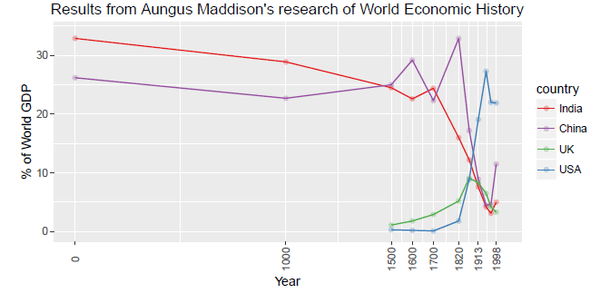Culture
Place Of Wealth In Indian Culture
Ashutosh Gupta
Mar 21, 2016, 11:12 AM | Updated 11:12 AM IST
Save & read from anywhere!
Bookmark stories for easy access on any device or the Swarajya app.


Introduction
One of the main reasons to look westward for answers of financial questions
is the fallacious assumption that ‘because Indian culture is centered around
spirituality and Dharma, thus it is indifferent towards the problems of the material
life’. This misconception is the result of a vitiated propaganda and a
misunderstanding of spirituality. This needs to be put in perspective with facts
and figures.
History: Philosphical Speculations vs Facts
It’s a fact that much of our perceptions about ourselves today comes from the western thinkers and historians. From Max Muller and Karl Marx, to the likes of Michael Witzel and Wendy Doniger, we have let our identities to be defined by the western historians. If we trace back the roots of ‘Western Indology’ our own self-perception was largely created by scholars who actually never visited India, who never dealt with Indians and who never read any Indian literature. Take two scholars, for instance, Karl Marx and Max Weber.
In the year
1853, before he wrote the Das capital, Karl Marx wrote couple of articles
which showed his understanding about India. He said that
economically if you look at the country, every village is an economic unit, a tariff
unit, and it doesn’t import or export anything. It produces and consumes making the producer the consumer as well and there
is no economic inequality because no one has any power over others. This was
called the primitive socialism in the communist terminology.
But Marx said there was something very wrong with this society- they worshiped
monkeys, and cows. He considered man as ‘the sovereign of
nature’, and accuses Hindus of degrading that man by ‘worship of nature’. Thus, such a backward
society can never progress and carry out a revolution which is necessary
for the advancement of human race.
It is necessary to destroy the social base and even though it is a painful destruction, it is a pleasurable destruction as well. This is what Karl Marx said. He never came to India, never read any Indian literature, never met any Indian but he wrote about India. And Marx became one of the most powerful thinkers influencing the Indian intellectual establishment. And our academics are still under the grip of these powerful thoughts.

Another person, Max Weber, a German philosopher is less known but he was a more powerful social thinker. In 1925 Max Weber wrote a book on
Hinduism and Buddhism. He said that two societies can never come up- China and India, because they believe in Karma and rebirth, which is anti-enterprise,
anti-entrepreneurial development, and so these two nations can never develop.
We defined ourselves through Karl Marx, through Max Weber, and then
came Professor Raj Krishna. He was asked “why India is growing so slowly?”
He said it is the ‘Hindu rate of growth’. That was 1978.
But a remarkable u-turn took place in 1970s, when Japan began rising as an
economic power. The west was surprised, because economic development, economic
progress is supposed to be the preserve of the west. How could Japan,
a Buddhist country from Asia, develop?
And so, one Paul Bairoch, a Belgian economist, made a thorough study of
the economic development of different nations from 1750 to 1980. He came
out with a surprising finding that, in 1750 if you draw a statistical chart
of the world, it would look like this: China was the top country in 1750 with
nearly 33 percent of world’s GDP and India was second with 24.5 percent of world’s GDP. UK had 1.8 percent of world’s GDP and USA had 0.1 percent of
world’s GDP.
He said that these were the structures of the world economy in
1750s. And India went down from 24.5 percent of the world’s GDP in 1750 to 20 in
1800, 17 in 1830, 8 in 1880, and finally 1.7 in 1900.
In just 150 years, the Indian economy,
the Indian polity, the Indian society, Indian civilization crashed. And the same
thing happened to China. From 33 percent in 1750, China became 6 percent in 1900. And
in the same period, UK and USA, which had just about 2 percent between them in
1750, their share went up to 41 percent in 1900.
This information completely transformed our understanding. Paradigm was shifted. Colonialism of 150 years transferred the power, economic , political and cultural power from Asia to the west.

When Paul Bairoch came up with this theory, the west was stunned. To be fully assured the OECD assigned Angus Maddison, the great economic historian to test and verify whether Paul Bairoch’s research was correct or not. OECD is group of the 26 richest countries in the world and their statistics are very much relied upon.All the 26 countries funded Angus Maddison and he was given a fleet of research scholars to work with. Angus Maddison started his work like this –
If Bairoch is right, then much of the backwardness of the third world, that is Asia, presumably has to be explained by colonial exploitation and much less of Europe’s advantage can be due to scientific precocity, continued slow accumulation of wealth and organizational, financial superiority. You cannot say it happened, our growth happened because of this, it has to be with colonial exploitation.
This is how Angus
Maddison started the work and said that Paul Bairoch cannot be correct.
Angus Maddison came out with the final conclusion in the year 2001 ,
and till June 2010, Angus Maddison kept on publishing his researches. He drew
a 2000 year economic history of the world starting from the first year of the
common era. He said if you look at the economic statistics in the year one of the
Common Era, India tops the world with 34 percent of world’s GDP, China next.
In the year 1000, if you draw the economic statistics, India leads with 28 percent. In the year 1400, India again leads, in the year 1500, India again leads, in the year 1600, China overtakes India, in the year 1700, India overtakes China.
Angus Maddison came to the conclusion that Indian economic crash occurred essentially and wholly because of colonial exploitation. The OECD, forum of 26 wealthiest nations, has declared this as the most authentic economic history of the world.

From factual evidence, we will move on to what the Hindu scriptures actually say, in the next part.
References-
1. Swāmināthan Gurumūrthy. Globalization and indian society-https://hinduway.wordpress.com/2014/12/25/globalization-and-indian-society-gurumurthy/ [Online; accessed 28-October-2015].
2. Karl Marx. The British rule in India. New-York Daily Tribune, 1853.
3. M Weber and HH Gerth. The religion of india: the sociology of hinduism and buddhism. 1958.
4. Wikipedia. Hindu rate of growth- https://en.wikipedia.org/wiki/Hindu_rate_of_growth.[Online; accessed 2-March-2016]
5. Paul Bairoch. International industrialization levels from 1750 to 1980. Journal of European Economic History, 11(2):269, 1982. 3
6. Angus Maddison. The world economy: A millennial perspective. Paris: Organization for Economic Cooperation and Development, page 263, 2001.





